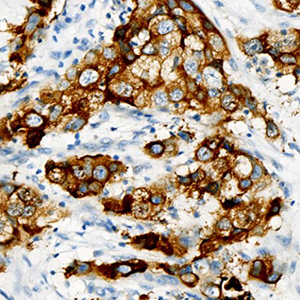Mammaglobin, GATA-binding protein 3 (GATA3), and epithelial growth factor receptor (EGFR) expression in different breast cancer subtypes and their clinical significance

Submitted: 6 August 2021
Accepted: 31 March 2022
Published: 7 April 2022
Accepted: 31 March 2022
Abstract Views: 785
PDF: 550
Supplementary: 102
HTML: 14
Supplementary: 102
HTML: 14
Publisher's note
All claims expressed in this article are solely those of the authors and do not necessarily represent those of their affiliated organizations, or those of the publisher, the editors and the reviewers. Any product that may be evaluated in this article or claim that may be made by its manufacturer is not guaranteed or endorsed by the publisher.
All claims expressed in this article are solely those of the authors and do not necessarily represent those of their affiliated organizations, or those of the publisher, the editors and the reviewers. Any product that may be evaluated in this article or claim that may be made by its manufacturer is not guaranteed or endorsed by the publisher.
Similar Articles
- A. Demirovic, S. Cesarec, Z. Marusic, D. Tomas, M. Milosevic, T. Hudolin, B. Kruslin, TGF-β1 expression in chromophobe renal cell carcinoma and renal oncocytoma , European Journal of Histochemistry: Vol. 58 No. 1 (2014)
- A.C. Croce, G. Bottiroli, New light in flavin autofluorescence , European Journal of Histochemistry: Vol. 59 No. 4 (2015)
- Valeriia Gusel'nikova, Olga Antimonova, Elena Fedorova, Mikhail Shavlovsky, Aleksandr Krutikov, Ekaterina Mikhailova, Aleksandra Gudkova, Vyacheslav Mikhailov, Dmitry Korzhevskii, Fluorescent characterization of amyloid deposits in the kidneys of mdx mice , European Journal of Histochemistry: Vol. 62 No. 2 (2018)
- Y. Shinohara, K. Okamoto, Y. Goh, N. Kiga, I. Tojyo, S. Fujita, Inhibition of fibrous adhesion formation in the temporomandibular joint of tenascin-C knockout mice , European Journal of Histochemistry: Vol. 58 No. 4 (2014)
- I.C. Šoštarić-Zuckermann, K. Severin, M. Huzak, M. Hohšteter, A. Gudan Kurilj, B. Artuković, A. Džaja, Ž. Grabarević, Quantification of morphology of canine circumanal gland tumors: a fractal based study , European Journal of Histochemistry: Vol. 60 No. 2 (2016)
- D. Stępiński, Immunofluorescent localization of ubiquitin and proteasomes in nucleolar vacuoles of soybean root meristematic cells , European Journal of Histochemistry: Vol. 56 No. 2 (2012)
- G. Orsini, A. Majorana, A. Mazzoni, A. Putignano, M. Falconi, A. Polimeni, L. Breschi, Immunocytochemical detection of dentin matrix proteins in primary teeth from patients with dentinogenesis imperfecta associated with osteogenesis imperfecta , European Journal of Histochemistry: Vol. 58 No. 4 (2014)
- Y. Zhao, H. Huang, Y. Jiang, H. Wei, P. Liu, W. Wang, W. Niu, Unusual localization and translocation of TRPV4 protein in cultured ventricular myocytes of the neonatal rat , European Journal of Histochemistry: Vol. 56 No. 3 (2012)
- T. A. Osman, G. Øijordsbakken, D. E. Costea, A. C. Johannessen, Successful triple immunoenzymatic method employing primary antibodies from same species and same immunoglobulin subclass , European Journal of Histochemistry: Vol. 57 No. 3 (2013)
- S. Strobel, J.A. Encarnação, N.I. Becker, T.E. Trenczek, Histological and histochemical analysis of the gastrointestinal tract of the common pipistrelle bat (Pipistrellus pipistrellus) , European Journal of Histochemistry: Vol. 59 No. 2 (2015)
<< < 28 29 30 31 32 33 34 35 36 37 > >>
You may also start an advanced similarity search for this article.

 https://doi.org/10.4081/ejh.2022.3315
https://doi.org/10.4081/ejh.2022.3315











